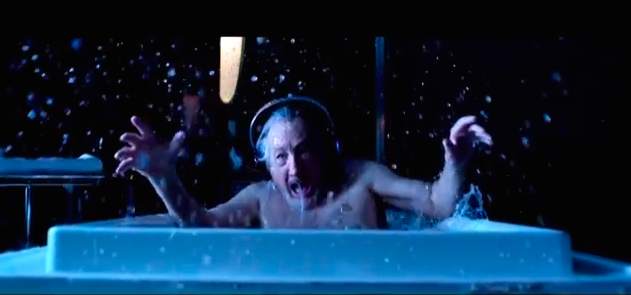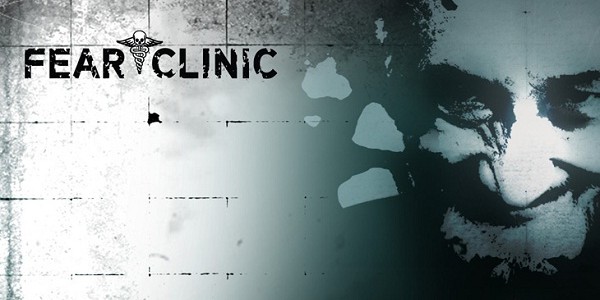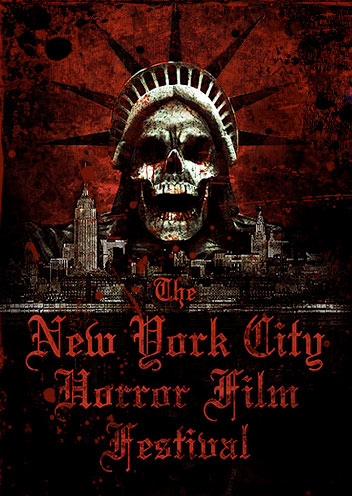We’re happy to present Matthew Monagle’s take on the first evening of the 13th annual New York City Horror Film Festival, which continues through the weekend! What follows is a take on Thursday’s entire programming slate, three short films and then a high-profile feature.
Click here for the full run-down of screenings for tonight, tomorrow, and Sunday.

MINERAL
A man’s gallstones come to life and try to find their way back into his body. MINERAL is the perfect pairing for a movie like FEAR CLINIC – it is what it is, and your opinion of the short film is directly proportionate to your response to my one-sentence plot synopsis. For those with enthusiasm for the subject – or just a morbid sense of curiosity – MINERAL does play it relatively straight, aiming more for body-horror than the hybrid-comedy approach. The short does have one pretty smart little trick up its sleeve: the main character is stalked around his apartment while a black and white documentary about the process of childbirth plays on his television (and provides much of the soundtrack for MINERAL itself). The graphic scenes of childbirth from the ’50s film seemed to shake the audience more than any amount of penis monsters; MINERAL seems to slyly suggest itself as the home economics video that will help men relate to what their partners are going through.

DISENGAGED
In a quiet suburban neighborhood, one cheerful woman looks after the immobile living corpses of her next door neighbors. I will always be a sucker for films that blend horror and the boundless optimism of post-war America, so DISENGAGED worked its magic on me pretty quickly. The movie suggest that a lunar eclipse has caused everyone to physically freeze and slowly begin to decompose; the lead woman has created boundaries of her neighborhood and follows a daily routine of moisturizing what is left of her neighbors faces. The main problem with DISENGAGED was its length: as much as one can have a too-long short, the film nails its sardonic tone and then tacks on an extra five minutes that carries it back to more familiar territory. One wishes that the filmmakers had stuck with the day-in-the-life approach and ended on a loop.

EYE IN TUNA CARE
In a world of mouths, an eye visits the dentist. Oh, how I loved this little animated film. That is all you need to know.

FEAR CLINIC
Let’s say that I have allergies. For years, my allergy medication has allowed me to live symptom-free, but recent trips outdoors have caused my eyes to swell up and my nose to run. I visit my personal physician, who originally prescribed me my medication, and he tells me that this particular line of allergy medication has been discontinued. I push the subject and my doctor – who, by the way, now sees patients in the parking lot of his former clinic – admits that he’s not sure the allergy medication ever worked. He also tells me that he reluctantly prescribed the medication again recently and it killed his only remaining patient. Being wholly incompetent, I demand more allergy medication, and he relents; later he tells me that he’s always thought that the allergy medication is what caused my allergies in the first place, but not before several more people die after taking the pills.
Replace allergies with fear, and allergy medication with a high-tech hyperbolic chamber, and you have the basic plot outline of FEAR CLINIC. Years ago, Dr. Andover (Robert Englund) built a hyperbolic chamber that chemically-alters the amygdala and allows patients to overcome life-long fears. The core of Andover’s patients shared a single traumatizing event: a mass shooting that heightened his patients’ sensitivity to their fears and prevented them from functioning in society. The success of Dr. Andover’s procedure seems short-lived, however, as the patients begin to suffer from the same waking hallucinations that the good doctor’s treatment triggered to help them address their phobias. Reunited years after the event, this group of patients begins to realize that, quite literally, the only thing to fear is fear itself.
Much like my make-believe physician, Dr. Andover is a terrible doctor. The science behind his experiments – what little is explained, anyways – is laughably bad. It’s not just that his methods are unorthodox; to keep to the story as outlined, Andover and his patients must make – and continue to make – a series of decisions that push beyond the boundaries of ignorance into some new, fantastic realm of horror movie decision-making. Even worse, the film seems to use this threadbare storyline as a pretense to deliver every possible kind of movie scare. The dream sequence, the false dream sequence, the creature camera, the shape-shifting monster, the supernatural monster, the serial killer; if some random combination of words on a page allow for you to mesh pseudo-science with blood spatter, then FEAR CLINIC found time for it on the screen.

And yet, there does seem to be some method to the film’s madness. Writer-director Robert Hall is a visual effects artist by trade, and while no parts string together to form a coherent movie, there are many sequences that stand out on their own. Andover is haunted by the first patient that he let die; the fear entity takes her form in Andover’s hallucinations to communicate directly with him, leading to nice bits of surrealism and physical contortion – not on Englund’s part, mind you – that stand out amidst the chaos. We are also treated to the phobias of each of Andover’s patients – nyctophobia, arachnophobia, claustrophobia, and body dysmorphia – and their connections to the mass shooting. The shooting itself is seen from the various perspectives of Andover’s patients, allowing Hall and his crew the opportunity to create a passable crime thriller in the midst of their horror film. FEAR CLINIC is not a particularly cheap film; the budget is estimated at north of one million dollars, and Hall and his crew do not scrimp on showing the fears of his characters. The violence and gore in FEAR CLINIC looks good, and everyone involved knows it.
Also helping the film is the talented cast. Since the film does star Robert Englund, you can be assured that he will eventually find himself as the face of the creature, but Englund’s scenes as Dr. Andover remind audiences that there is real talent underneath the red-and-black sweater. Hall mentioned during a post-screening Q&A that he and Englund have a history that dates back to early-‘90s Roger Corman films, and both director and star do their best to make the other look good. The film also benefits greatly from Thomas Dekker, another previous collaborator with Hall, who takes on a particularly challenging role as a gunshot victim who suffers from severe brain damage and subsequently has little motor control. FEAR CLINIC asks a lot of Dekker, requiring that he go through a complicated character arc that, again, doesn’t really add up in the end, but Dekker manages to breathe some life into his character and wrest some honest-to-god pathos out of the script. These may not be the types of roles that Dekker had hoped for after his successful stint on THE SARAH CONNOR CHRONICLES, but I found myself comparing him to Casey Affleck and Desmond Harrington after the screening.
Ultimately, FEAR CLINIC is one of those films that belong to the separate scale reserved for horror enthusiasts. Any objective evaluation of the film would burn it all down on the merit of the script alone; and yet, I’d be willing to bet that fans of the genre will find some moments in there worth keeping. The fun thing about being a horror fan is that we’ve always seen worse, and so when we see movies that do something right, we’re less prone to throw the baby out with the bathwater. Hall and Englund are each in fine form with what they do best. If your criteria for FEAR CLINIC falls outside these two men, well, why the hell were you watching FEAR CLINIC to begin with?

— MATTHEW MONAGLE (@LabSplice).

- [THE BIG QUESTION] WHAT’S YOUR FAVORITE FEMALE ENSEMBLE IN MOVIES? - July 22, 2016
- [IN THEATERS NOW] THE BOY (2016) - January 24, 2016
- Cult Movie Mania Releases Lucio Fulci Limited Edition VHS Sets - January 5, 2016
Tags: cartoons, Fiona Dourif, gore, Horror, Kevin Gage, New York, Rob Hall, Robert Englund, Screenings, Thomas Dekker







No Comments